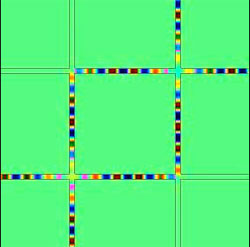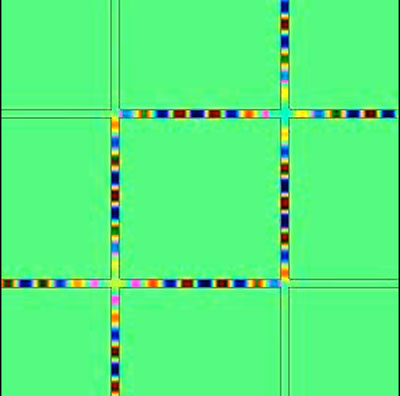New Material: Network of ‘Streets’ for Light
In recent years, researchers have created early versions of “invisibility cloaks” and advanced optical fibers by manipulating light using structures composed of tiny, repeating units. In the 9 April Physical Review Letters, a team proposes a different way to make an artificial optical material–from a network of light-guiding filaments. If such structures are practical, they could open new ways to control light in technologies ranging from high-speed telecommunication to high-resolution imaging.
One well-known light-shaping structure, called a photonic crystal, is an artificial two- or three-dimensional periodic array, such as a cube of clear plastic with closely-spaced air holes drilled into it. The interference of waves traveling through the structure favors reflection of some wavelengths of light, which leads to brilliant colors, in the case of butterfly wings that contain similar microscopic structures. In another technique, researchers arrange tiny, antenna-like structures to create “metamaterials.” These structures can have optical properties unknown in nature, such as a negative refractive index that can render objects partially invisible or possibly lead to a “perfect” lens [see Focus story from 2002].
But in both of these designs, light waves bounce throughout the volume of the material to produce the desired effects. Now Eyal Feigenbaum and Harry Atwater of the California Institute of Technology in Pasadena propose a different scheme, in which light signals travel only along predefined linear paths, or waveguides, that intersect at many locations. By choosing the lengths of the various routes between any two intersections, or by tweaking the speed the waves travel in different waveguides, the researchers can control whether particular wavelengths reinforce or cancel. Moreover, the properties can vary from place to place, which contrasts with the uniformity of a photonic crystal. “The ability to control the properties of the waves in any location is the big advantage here,” Feigenbaum says.
To illustrate the concept, the researchers performed extensive computer simulations of two-dimensional networks of waveguides. Each waveguide consisted of two “rods” of gold with a tiny air gap between them confining the light. When the gap is much smaller than the wavelength, the light waves are strongly coupled to the metal. Any light hitting an intersection between two waveguides scatters out in equal amounts in all four directions, according to Feigenbaum’s previous work [1] (see first video below). He and Atwater have now calculated how light travels in an infinite grid of such city-street-like intersections.
Imagine two pulses of light that approach an intersection along two perpendicular “streets.” It turns out that if the two pulses are in phase–their waves are synchronized–light will not emerge in the reverse directions and will only exit from the two forward streets. But if the two pulses are out of phase, they interfere in a way that sends the light out only in the directions it came from. This means that pulses can be trapped around a single “city block” in the grid, colliding and reflecting back whenever they meet at intersections. The researchers calculated that pulses will bounce dozens of times in such a resonator before they die out (see second video below).
The long lifetime allows more complex effects to emerge, arising from light traversing many possible loops in the complete grid. For example, the researchers found that some ranges of wavelength are completely “forbidden” from propagating–one of the defining characteristics of photonic crystals. But the network design may allow new flexibility, Feigenbaum says. For example, even a small network could be tuned to select particular wavelengths for optical communications. Alternatively, synthetic optical materials used for lenses could be improved by designing the properties of the network to vary with position. The team is well along in making experimental structures to test their predictions, and the calculations suggest that similar effects should occur in three dimensional structures as well.
The proposed structure is “more than an intermediate between previously existing periodic systems,” says Henri Benisty of the Institute d’Optique in Palaiseau, France. It might be built using standard semiconductor chip technology, he says, but he wonders whether the critical intersections can be made precisely enough for large-scale arrays.
–Don Monroe
Don Monroe is a freelance science writer in Murray Hill, New Jersey.
References
- E. Feigenbaum and M. Orenstein, “Perfect 4-way Splitting in Nano Plasmonic X-junctions,” Opt. Express 15, 17948 (2007)
More Information
Some Related Focus stories:
Light at the End of the Tunnel Left-Handed Materials Debate Heats Up





